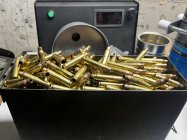I’ve graduated from standing cases upright on a cookie sheet and simply moving the torch from case to case, to spinning cases by hand in a 1/4” drive deep socket and extension. Your setup looks quite good.I’m in full agreement with the OP, we could use some simple data just testing seating pressure SD’s after annealing by various methods —sorry if I missed it, I’m sure it’s probably out there somewhere and I probably saw it and forgot about it.
I do “manual” annealing after each firing, using propane torches and metronome, all equipment from anneal-rite.com (attached).
It’s not expensive and the primers you reload with are probably much more dangerous than the propane torch— I keep a fire extinguisher close by.
When I skip annealing it seems like I get variation in seating pressure (K&M arbor press with a force pack and guage installed) from one reloading session to the next.
I would say if your seating pressures within one reloading session are +/- 10%, such as 30 lb +/- 3 lbs for my 30 cal, and if they stay at 30lb after several firings, then you’re good to go. If not then try something different.
I’ve been able to get that by heating for 7-10 sec until 750F Tempilaq changes color, or maybe just a second longer. I may not be “annealing”, but so far all I care about is consistency in seating pressure.
And accuracy has been competitive on occasion in both F class and BR, including 1k yd.
If I get richer I’ll spend some more $ and get the Amp.
Nobody in my social circle has an auto annealer, but my nephew and I will send some cases off to an annealing service and shoot them vs our hand annealed brass. Hand annealing can create an off center color discoloration, it will put my mind at ease testing an off center anneal. That probably should have been the title of this post.
As a science project we might take a pneumatic cylinder and pressure gauge to measure seating pressure as well.











